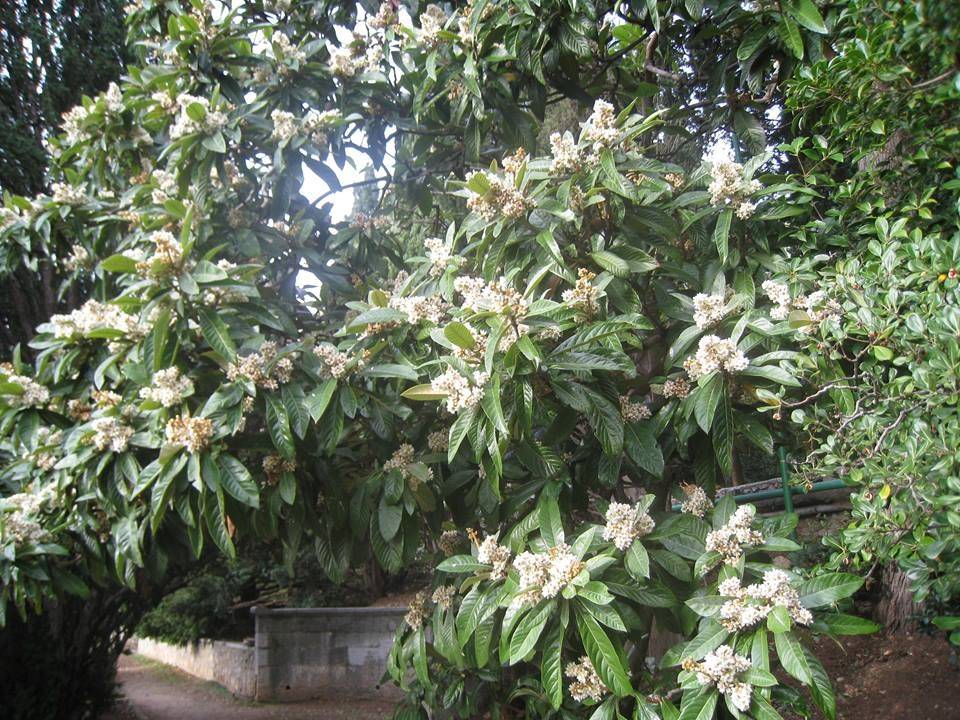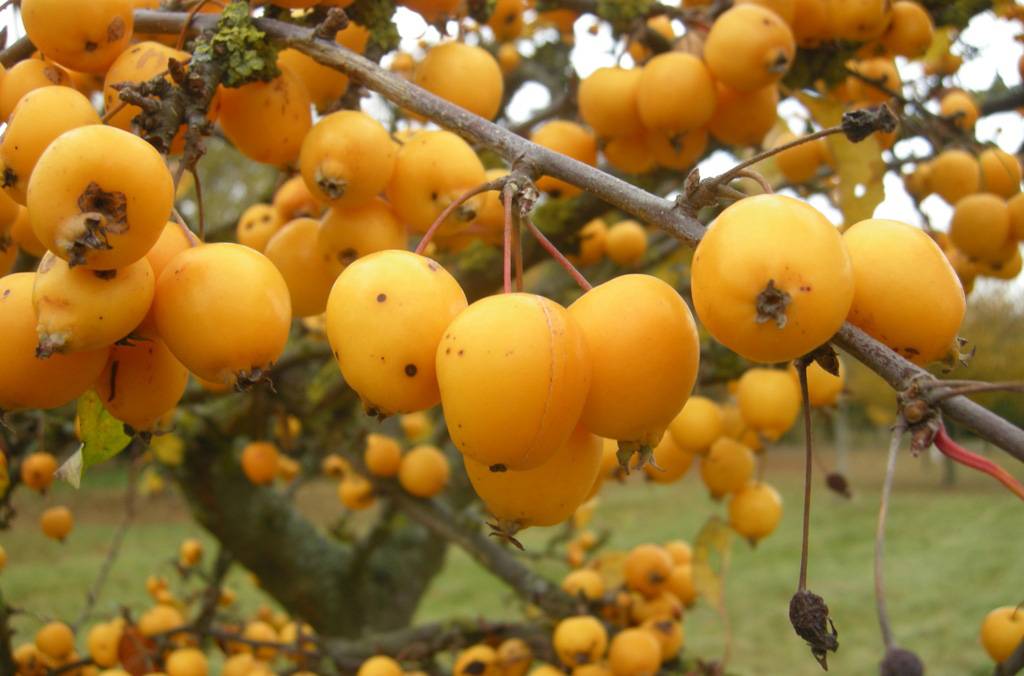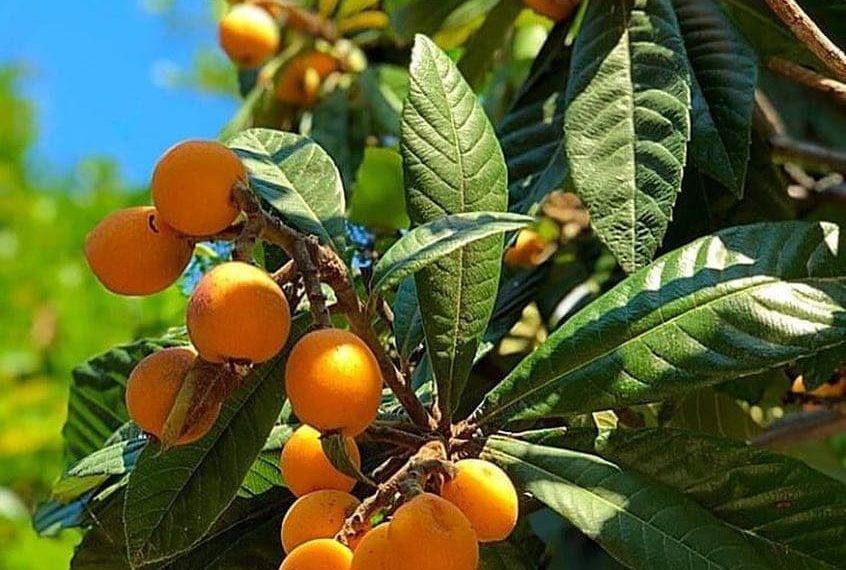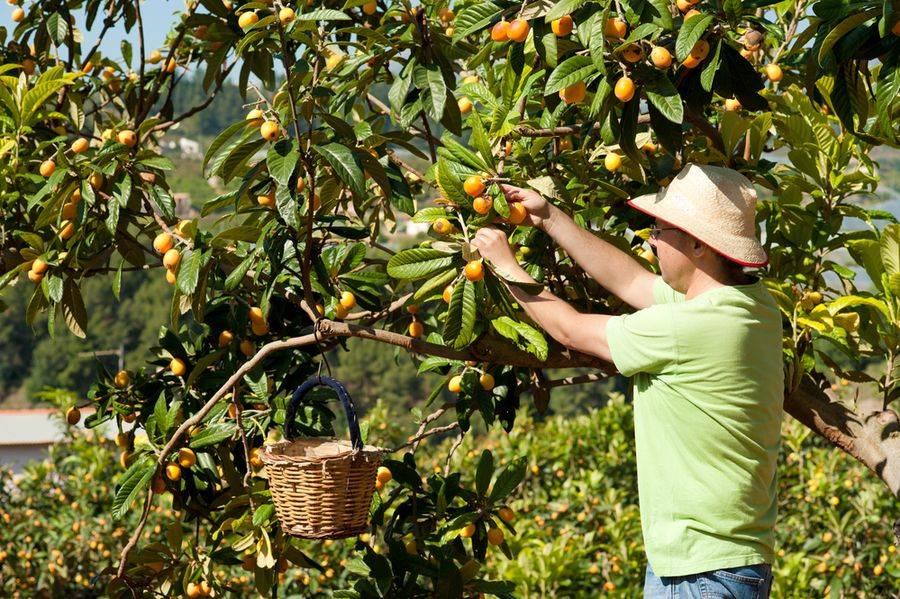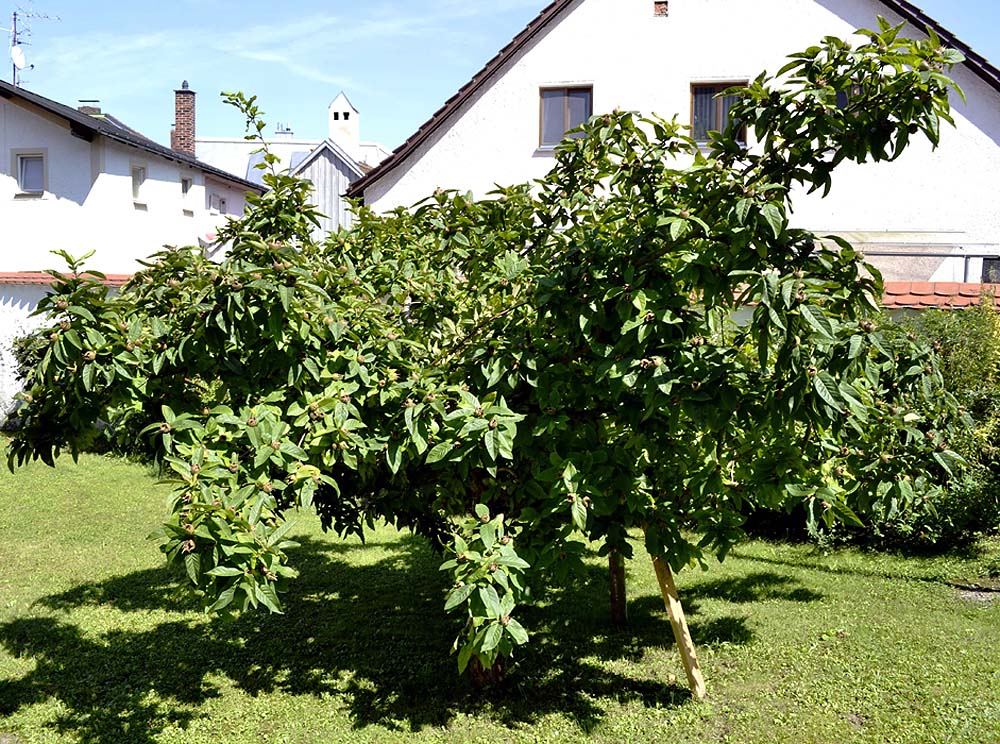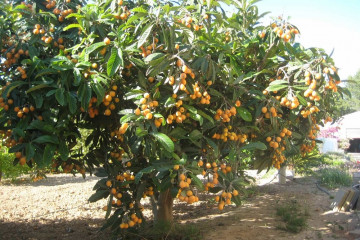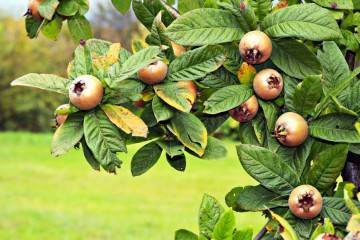Fruit Medlar - what is this tree, care
Content:
Medlar belongs to the category of deciduous plants. Often, gardeners call a representative of the Pink family of cups trees, loqua. Experts distinguish several types of culture. Only 2 types can be used in gardening. The information presented below will allow you to understand what a medlar is, a berry, a fruit or a tree.
Description and useful properties
Having met an unusual fruit and paying attention to the name, many compatriots are interested, medlar - what is it? In fact, medlar is a fruit that grows on trees and has an amazing taste.

Lokva (one of the names of the fruit) is an evergreen tree, the fruits of which have beneficial properties
If you create favorable conditions for the culture to grow, the tree can reach more than 10 m in height. In this case, the width will be within 3-4 m. The bark of this fruit tree is painted in a dark gray palette.
Leaf plates turn orange with the onset of autumn and gradually begin to turn red. In late spring or early summer, five-petal flowers, painted in a white palette, form on an evergreen tree. The scent that comes from the flowers attracts pollinating insects.
What does the medlar fruit look like? The fruits are endowed by nature with a pear-shaped or spherical shape. Their diameter is in the range of 20-30 mm. The red sepals are in a permanent unfolded position. The taste of ripe fruits is sour.
Medlar fruits should be stored for a long time after being removed from the tree so that they become a little sweeter. Only then will the fruit taste soft and tender.
The composition of the medlar is balanced. The fruit has a large number of useful properties that allow you to cope with diseases such as asthma, hypertension, bronchitis. There is indeed a benefit from a fruit that tastes like quince.
If you systematically eat medlar, you can:
- remove kidney stones;
- stabilize the digestive system;
- cleanse the body of toxins and toxins;
- cope with intestinal colic and diarrhea;
- strengthen the immune system (you can prepare various tinctures);
- make up for the lack of useful elements in the body;
- reduce the percentage of blood sugar;
- prevent heart attacks and strokes.
In diseases of the gastrointestinal tract, the use of loqua can be harmful.
Varieties of fruit tree
There are only 3 types of medlar, but only 2 varieties described below can be used in horticulture.
Japanese medlar
A spreading tree, the height of which can reach 7-8 m. The bark is painted in a dark brown palette. Oval leaf plates have a pubescent leathery surface.
The blooming of paniculate inflorescences is observed in early autumn. Each inflorescence consists of flowers, colored in white and yellow shades. The diameter of the flowers is in the range of 10-20 mm.
The fruit tree variety prefers warm climates and rocky ground. The fruits formed on the loqua are naturally endowed with pear-shaped / rounded outlines. Medlar is located on the branches in the form of bunches.
Juicy berries have a pleasant aroma. Their skin is colored in a bright yellow palette.
German medlar (Abkhazian, Caucasian)
Belongs to the category of deciduous plants that can reach a height of 7-8 m.
Strongly branching shoots are dotted with dark green foliage, which has an oval shape. Fruits begin to ripen in the autumn months.
What kind of fruit does the Caucasian medlar have? The peel of the rounded berries is colored red-brown. After the onset of frost, the fruits become soft and sweet in taste.
Where does this species grow medlar? Due to the good frost resistance of the variety, it can be successfully grown outdoors in regions with a temperate climate.
Growing medlar from a bone at home
Medlar is an exotic plant that can be grown independently from a stone at home.
After removing the seed from the fruit, dry it on a plate for about 36 hours. After a specified period of time, it will be ready for planting in the soil mixture.
The step-by-step planting process looks like this:
- To plant medlar seeds, you will need to prepare a soil mixture consisting of humus, peat, leafy soil and sand.
- The soil mixture is poured into a previously prepared container. Do not forget about the need to create a drainage layer on the surface of the bottom of the tank.
- The medlar bone deepens into the ground by only a couple of cm. Only 3-4 seeds are planted in one container. Cover the top of the container with a piece of glass.
- Place the container in a well-lit area. Every day the glass is removed for 10-20 minutes in order to ventilate. If necessary, the soil is moistened with a spray bottle. A month after planting, you can expect the first shoots to appear. As soon as the height of the seedlings reaches 2 cm, the cover is removed.
As soon as the seedlings reach a height of 2.5-3 cm, you can begin to dissect them in different containers. As a rule, most of the plants die during this period. Only the strongest will survive. The first flowering can be expected only 3 years after planting the seeds.
How to grow medlar in the garden
To buy seedlings, experts recommend going to a local nursery. When planting hybrids, follow the step-by-step guide below.
- In the selected area, planting pits are dug, the volume of which should be one third larger than the diameter of the earthen coma of a young tree.
- A drainage layer is laid on the surface of the bottom of the recesses. It can be made from expanded clay and bone meal.
- The seedlings are placed in the holes. The root system of each plant is covered with soil mixture.
- A support is dug in near each green space.
- The soil at the planting site is abundantly moistened. The area of the trunk circle is mulched with humus. The layer thickness should be between 25-30 cm.
Medlar does not need complicated care. The peculiarities of caring for the lobby are similar to the requirements for caring for the usual fruit trees such as apple, pear and plum.
Watering
Lokva, like quince, needs moderate soil moisture. Water stagnation in the area of the trunk circle should not be allowed.
During the period when the medlar plant blooms, the soil is systematically moistened, which will avoid loss of yield.
Top dressing
Systematic fertilization will have a positive effect on the quantity and quality of the fruit. Experienced gardeners recommend using organic matter and mullein as top dressing.
Pruning
In order to form the crown, it is recommended to systematically prune. In addition, it is important not to forget about the need for sanitizing shoots, which has a positive effect on the appearance of the crop and yield.
During the procedure, deadwood, damaged and diseased shoots should be removed. In the spring, the crown is thinned out. Unpromising branches should not interfere with fruit set. You can get rid of frozen branches without regret.
Reproduction of medlar
Medlar can be propagated in two ways:
- bones;
- by cuttings.
The step-by-step process of bone reproduction is described above.
Gardeners recommend giving preference to cuttings, which can be found below.
- As cuttings for reproduction, last year's shoots are perfect, the length of which is in the range of 16-20 cm.It should be borne in mind that there should be 2 nodes on each workpiece.
- Leaf plates are cut from the cuttings.
- The cut areas are treated with a small amount of wood ash.
- A soil mixture consisting of sand, humus, peat and a small amount of expanded clay is poured into pre-prepared containers.
- Cuttings are planted in the ground to a depth of about 4 cm.
- The soil is moistened.
- The container is transferred to a room that is well lit by the sun's rays.
- The rooting process takes about 5-6 weeks. Once the root system is formed, the plants can be transplanted to a permanent location.
How to replant an adult tree
Mature trees can be replanted no more than once every 4 years. However, every year the green space needs to change the top layer of the soil. Due to the endurance of the lokva, the soil for filling can be any:
- sandy;
- clayey;
- sour;
- neutral.
However, if the growth rate of the seedling is minimal for a long time, light, nutritious and well-drained soil should be preferred.
During the transplanting process, the plant is dug up. Its root system is carefully removed from the hole along with a clod of earth. The medlar tree is transferred to a new location. Carefully distributing the root system of the plant in the center of the previously dug hole, the resulting voids should be filled with soil mixture. The top layer of soil is compacted. 2-3 buckets of settled rainwater are poured under the tree.
Flowering features
Blossoming of a fruit tree can be expected no earlier than 3 years after planting. To ensure abundant flowering, it is important to follow the recommendations for the care of the crop.
The diameter of medlar flowers can reach 20-25 mm. The presence of a delicate pleasant aroma that comes from the inflorescences allows you to attract pollinating insects. The petals are painted in a white or creamy palette. The color of the stamens can be yellow or green. Flowers are collected in multicolor.
During flowering, a fruit tree can become a real decoration of the site.
Medlar in landscape design
Sprawling trees are often used by landscape designers in the process of landscaping a site.
The culture is planted in pairs near other shrubs. Fancy-shaped fruits add decorativeness to the plant. The medlar will look quite impressive if you plant it along the garden paths.The resulting alley, with closed crowns of trees, will become the main decoration of the site.
Diseases and pests
If the fruit tree is properly cared for, most diseases and pests can be avoided. Otherwise, medlar may suffer from:
- Spotting of leaf plates, the cause of which is the systematic waterlogging of the soil. Fungal spores that have multiplied against this background will persist for a long time in the upper soil layer. The leaf plates begin to become stained, yellow and lose density. An unpleasant odor emanating from the soil can also indicate spotting. In order to cope with the disease, it is recommended to cut off rotting roots and treat the plantings with copper sulfate.
- The drying out of the foliage signals the development of vitamin deficiency or improper watering. To cope with the unpleasant situation, you should systematically moisten the soil and apply organic fertilizers every month in the summer.
- A sooty fungus, the causative agent of which are fungal spores that actively reproduce in a warm environment. A plaque that resembles soot appears on the leaf plates. This interferes with photosynthesis. To cope with the sooty fungus, gardeners recommend systematically making vitamin and mineral supplements. Soot deposits are removed from foliage with a damp swab.
Scabbards and aphids can also harm the plant. The pests drink the juice of the foliage, as a result of which individual leaves curl up, dry out and fall off. It is important to systematically inspect the medlar and, if insects are found, remove them manually and spray them with Fitoverm.
The exotic loquat plant is popular with gardeners. It is quite easy to grow such a miracle of nature, especially in the southern regions. The most important thing is to follow the recommendations of specialists regarding plant care and systematically apply top dressing to the soil.
